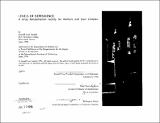| dc.contributor.advisor | Ellen Dunham-Jones. | en_US |
| dc.contributor.author | Frankel, Ronald Evan | en_US |
| dc.date.accessioned | 2011-10-17T21:18:33Z | |
| dc.date.available | 2011-10-17T21:18:33Z | |
| dc.date.copyright | 1996 | en_US |
| dc.date.issued | 1996 | en_US |
| dc.identifier.uri | http://hdl.handle.net/1721.1/66373 | |
| dc.description | Thesis (M. Arch.)--Massachusetts Institute of Technology, Dept. of Architecture, 1996. | en_US |
| dc.description | Includes bibliographical references (p. 71-73). | en_US |
| dc.description.abstract | Contemporary society is faced with an increasing problem of substance abuse and addiction. The public consequences of this private problem are experienced in the increasing costs in the healthcare, penal and welfare systems as well as the less tangible effects drugs and addiction have on the quality of our urban centers. Current efforts to solve this problem include education, substance abuse treatment and curtailing the availability of drugs. Although these efforts are effective they are not sufficient because traditional treatment programs exclude a critical group within the substance abuse population--women with dependent children. This group, whose most pressing concerns are education, domestic violence and substance abuse, has been growing at an alarming rate and if their needs are not addressed then their problems will be handed down to their children in an increasing cycle of dependence. A new model for treatment is needed; one which can accommodate women and their children and can recognize the advantages of maintaining and nurturing families rather than isolating patients and placing their children in foster care. Such a facility could capitalize on the mutual support offered within the family structure and could address the growing problem of substance abuse with the most vulnerable population--the children of drug addicted parents. The architectural proposal presented here expresses the complex levels of dependence found between the individual and society, the individual and the clinic and between the parent and child. The progress from dependence to independence is articulated through a series of typological transformations which map the transition from institutional to domestic living and symbolizes in the urban fabric a process of healing and growth, revitalizing both the city and its population. | en_US |
| dc.description.statementofresponsibility | by Ronald Evan Frankel. | en_US |
| dc.format.extent | 75 p. | en_US |
| dc.language.iso | eng | en_US |
| dc.publisher | Massachusetts Institute of Technology | en_US |
| dc.rights | M.I.T. theses are protected by
copyright. They may be viewed from this source for any purpose, but
reproduction or distribution in any format is prohibited without written
permission. See provided URL for inquiries about permission. | en_US |
| dc.rights.uri | http://dspace.mit.edu/handle/1721.1/7582 | en_US |
| dc.subject | Architecture | en_US |
| dc.title | Levels of dependence : a drug rehabilitation facility for mothers and their children | en_US |
| dc.title.alternative | Drug rehabilitation facility for mothers and their children | en_US |
| dc.type | Thesis | en_US |
| dc.description.degree | M.Arch. | en_US |
| dc.contributor.department | Massachusetts Institute of Technology. Department of Architecture | |
| dc.identifier.oclc | 35953258 | en_US |

